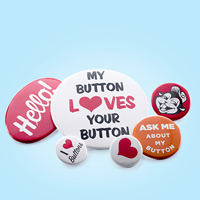A Nod To Nostalgia

Busy Beaver Button Co.
preserves the past and protects the planet while making pin-backed masterpieces and more.
One peek at Chicago, Illinois-based supplier Busy Beaver Buttons’s (PPAI 230145) website and you instantly know this supplier has an extra edge. The friendly, charming retro design is refreshingly fun and inviting. One pull-down menu shows the company’s cartoon character beaver mascot instructing visitors to “Hop on the Busy Beaver Bandwagon!” When you click on the ‘Contact’ link, the beaver appears again to say: “We’re here for You! Let’s talk. Give us a ring. Shoot us an email, or drop on by for a visit.”
Who wouldn’t want to take them up on their offer? It’s easy to imagine that stepping into their headquarters in Chicago’s Logan Square would be like stopping by an old friend’s house. Christen Carter, the woman who created this cheery company, found her calling while on a work-study semester in London while earning her comparative literature and film degree. “Buttons hadn’t been popular in the U.S. since I was a kid, but I noticed they were still a thing with my friends in London,” says Carter. “They never really went away.”
Carter returned to Indiana University in Bloomington after the semester was over and resumed classes, with the idea of starting her own button company. “My friend, Mark Pawson, an artist who’s been making buttons for a long time, offered to show me how to get started.” When one organization she contacted said that if she started a button company, they would order from her, she was off and running. She started the company in 1995, the same year she graduated from college. She contacted an artist whose work she admired, Archer Prewitt, and said, “Hey, I’m starting this button company. Would you be interested in drawing a character for it?”

Christen Carter with her company's bountiful button display.
He ended up drawing the company’s logo in exchange for 300 buttons and still occasionally contributes designs. The name of the company evolved over its first year in business. “The original name of the company was The Little One-Inch Button Company, but in 1996 I renamed it Busy Beaver Buttons because I knew I wanted to do more than just one-inch buttons at some point,” Carter says. “The name came from an old children’s book my mom had, called Busy Beavers, which was about these very industrious beavers.Plus, I thought it was funny.”
From the beginning, the company has always had a commitment to U.S.-made products and to the environment. “It’s important for the whole country’s economy,” Carter says.
“All of our supplies are made in the USA [the company uses steel from Gary, Indiana, machinery and paper from Wisconsin, and paper from French Paper Company in Niles, Michigan] which makes it easier when dealing with issues or short turnaround. We want the control to make quality products as quickly as our customer needs them and our local suppliers help us do that.”
One of the company’s core values is Give A Dam (notice the beaver pun). To Carter, it means “we care a lot about our customers, but it extends to caring about the environment. I’ve always thought you should leave the planet better than you found it—I’d like the world to be around for a long time so we can continue making buttons! Also, it’s an industry to help move along and create more and more jobs for our country.”
When the company outgrew its 1,400 square-foot space and purchased a larger space nearby with twice the amount of square footage, Carter made sure all the renovations were eco-friendly, even when they ended up costing more than she planned.
“We had budgeted $80,000 to install geothermal heating and cooling again (our previous building has it), but it ended up being around $130,000. So we didn’t stay in budget, but geothermal is a long-term investment,” Carter explains. On the other hand, using reclaimed materials saved money during the renovation process. “We like the looks of the old stuff better, like our slop sink [a deep sink designed for messy tasks] and interior windows, which are beautiful old windows from a Tudor mansion that were only $35 apiece from an architectural salvage place. If we bought them new, they wouldn’t have had the character we wanted, or they would have been way more expensive,” she adds.
The space is large enough to house the company’s button museum—the world’s only tribute to buttons—which features buttons dating back to 1896, and is free and open to the public. “We created the Button Museum to show how people commemorated noteworthy times in their lives by creating and collecting these wearable mementos,” Carter states on the museum’s website.
Carter is proud that the company she owns has grown every year since it began (it’s now a 25-person operation making more than 3.5 million buttons per year), and she is optimistic about the future. “The 2018 elections aren’t far away, meaning candidates will be ordering lots of buttons,” Carter says. “Usually midterm elections aren’t too busy, but we expect an uptick. We are also working on creating new, innovative button packaging options.” Besides buttons, the company makes promotional magnets, mirrors and bottle openers.
Looking back on her nearly 22 years in the button business, Carter says she’s proudest of “. . . setting up a business that attracts such amazing people. I’m so proud to work with all these great people, both customers and coworkers.”
Julie Richie is a former associate editor for PPB.
Going Green
Christen Carter’s Tips For Becoming A More Environmentally Conscious Company
• Ask your suppliers what they do to reduce waste. If you would like them to do more, suggest that it’s important to you.
• When renovating, use reclaimed materials. They can often be less expensive, and it saves the items from the landfill.
• Research green building materials. For example, certain types of insulation not only
perform better but also can save materials from landfills. The U.S. Green Building
Council at www.usgbc.org is a good place to start.
• See alternative power as a long-term investment. Things can be more expensive on
the front end, like solar power and geothermal heating and cooling, but it does pay off.
Check on state and federal tax incentives too.

